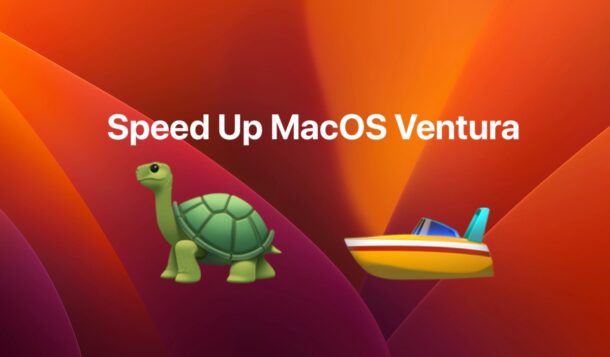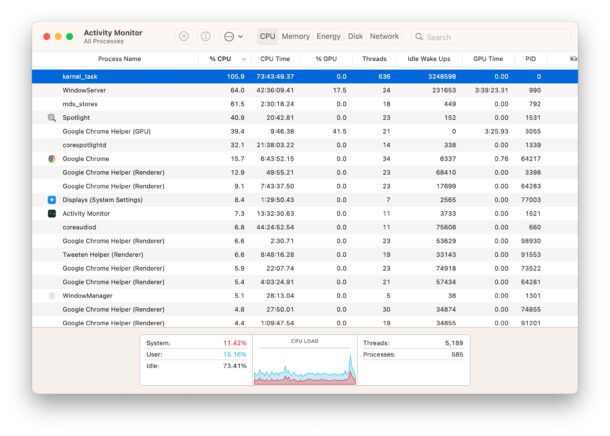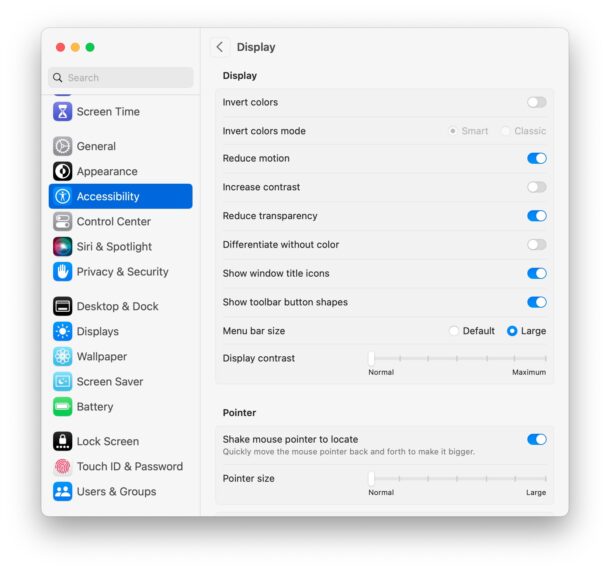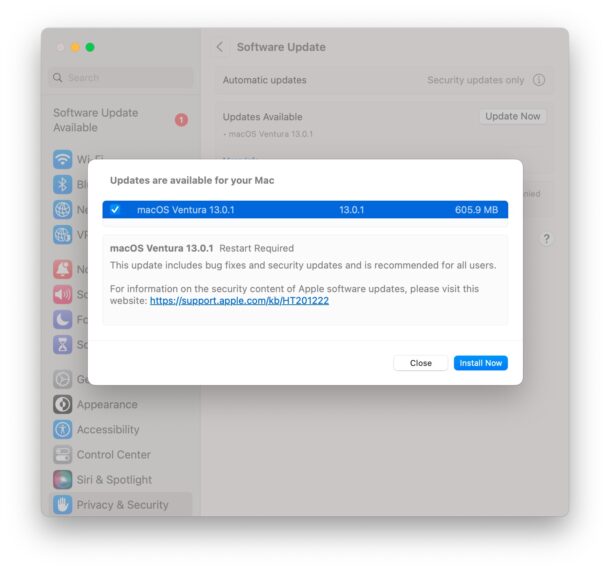Is MacOS Ventura Slow? 13+ Tips to Speed Up Performance

Some Mac users feel that macOS Ventura is much slower than macOS Monterey or Big Sur, offering worse performance in general, and when performing the same tasks on their Mac.
It’s not unusual for users to feel that their computer is slower after a major MacOS update, and Ventura is no exception. If you feel like your Mac is notably slower or more sluggish, perhaps with slow app performance, more beach balling, or other unusually slow behavior when trying to use your computer, read on.
1: Mac is Very Slow After Updating to MacOS Ventura
If the update to macOS Ventura was recent, within the last day or few, it’s likely that the Mac is slow because background tasks and indexing are occurring. This happens with every major system software update.
The best way to resolve slow performance after a major system software update like macOS Ventura is to leave the Mac plugged in (if it’s a laptop) and powered on, and let it sit idle while you go on with life away from the computer. This allows the Mac to perform routine maintenance, indexing, and other tasks, and performance will return to normal when this completes.
Usually simply leaving a Mac on and plugged in overnight is enough to resolve these type of issues after updating system software.
2: Is the Mac Older? Limited RAM?
MacOS Ventura has stricter system requirements than prior macOS releases, and some users have noticed that MacOS Ventura appears to run slower on older Macs, or Macs with more limited resources like insufficient RAM or disk space.
Generally speaking, any newer model Mac with 16GB RAM or more, and a nice speedy SSD, will perform quite well with MacOS Ventura. Macs with 8GB RAM or less and slower spinning hard drives may feel more sluggish, particularly when using a lot of apps at once.
3: Mind Messages
The Messages app on Mac is a lot of fun, but if you frequently exchange stickers and GIFs with people, having those Messages windows open can really slow down performance on the Mac by allowing the Messages app to run amuck with resources to loop the animated GIF or render other Messages media content.
Simply quitting out of Messages when not in use, or even selecting a different message window that doesn’t have a lot of active media content, will help performance here.
4: Find Resource Heavy Apps with Activity Monitor
Sometimes apps or processes you aren’t expecting to be eating up CPU or RAM are doing so, causing the computer to feel slow.
Open Activity Monitor on the Mac by hitting Command+Spacebar to bring up Spotlight, type “Activity Monitor” and hit return.
Sort by CPU use first, to see what, if anything, is using a lot of your processor. If something is open that is not in use and using tons of processor, that app or process may be why the Mac feels slow.

If you see kernel_task grinding away constantly, it’s likely because you have tons of apps or browser tabs open, and the kernel is swapping things in and out of virtual memory.
WindowServer is also often because there is a lot of active apps or media on the screen, we’ll touch on that more in a moment.
Google Chrome is a great web browser but it’s notorious for using a lot of system resources like RAM and CPU, so if that’s open with dozens of tabs or windows, it may be dragging down performance on the Mac. Using a more resource conservative browser like Safari may be a solution to this issue, or simply having less windows and tabs open in Chrome whenever possible.
More advanced users can also try force quitting apps and processes that are using a lot of CPU or RAM, but keep in mind that force quitting apps may cause data in those apps to be lost, like browser sessions, or anything that is not saved.
You also may see processes that you don’t recognize but taking up a lot of system resources, like ApplicationsStorageExtension, which uses heavy resources to draw the ‘storage’ usage data screen on a Mac, and simply closing that window will allow that process to ease off.
5: WindowServer Heavy CPU Usage & RAM Consumption
You may see ‘WindowServer’ process that is using a lot of CPU and system memory. This is usually because you have a lot of windows or apps open on the Mac.
Closing windows, media windows, apps, browser tabs, and browser windows, will allow WindowServer to settle down.
You can help WindowServer use less resources by disabling transparency and visual effects on the Mac, but if you have dozens and dozens of apps and browser tabs open, it will still likely be using a lot of system resources to draw those windows on the screen.
6: Turn Off Visual Effects and Eye Candy like Transparency and Motion
Turning off visual eye candy on the Mac can help to free up system resources so they aren’t used for visual effects.
- Open the Apple menu and go to “System Settings”
- Choose “Accessibility” preferences
- Select “Display” settings
- Toggle the switches for “Reduce motion” and “Reduce transparency” to be enabled

This will change the visual appearance of the Mac a bit as well, usually making windows and titlebars appear brighter and white compared to more subdued grays and hues. But, it should use less system resources as well, potentially increasing performance.
Turning off transparency has been a trick to speed up Macs for quite a while, and it works particularly well on older machines with less system resources in general.
7: Tidy up the Mac Desktop
If your Mac desktop looks like a disaster of hundreds of files, that can slow performance on the Mac.
This is because each thumbnail and file on the desktop uses resources to draw on screen, and so simply throwing everything from the desktop into another folder and preventing them from being visible can instantly speed up a Mac by using less resources.
Another option is to hide all Mac desktop icons which basically disables the desktop (but not the Finder), preventing anything from being visible on the desktop. But for most users, simply throwing everything from the desktop into a folder is good enough.
8: Install macOS Ventura Updates When Available
Apple will continue to refine macOS Ventura and release software updates for the operating system, and you should install them when they become available, as they may resolve bugs that could result in performance issues.
- From the Apple menu, go to “System Settings” then choose “General” and go to “Software Update”
- Install any available software updates to Ventura

9: Update Your Mac Apps
Don’t forget to update your Mac apps regularly, as they may be optimized for performance, or resolve bugs impacting performance.
The App Store is where you’ll update many apps on the Mac by going to the App Store > Updates
Some apps like Chrome can update automatically, or manually through the About Chrome menu item.
Install any and all available app updates for macOS Ventura, this is good system maintenance anyway.
10: Is the Mac Slow, or is Wi-Fi / Internet Slow?
Some users may have slower wi-fi or internet connection issues, which means when trying to browse the web or use internet based apps, everything feels slower. But if that’s the case, the Mac itself may not be slow, it may just be the internet connection.
You can follow this guide for resolving wi-fi and internet connection problems in macOS Ventura which may help.
11: Why is My Mac Frequently Beach-balling in Apps, Slow App Performance
This is likely a resource issue unrelated to macOS Ventura, so if you’ve got another app open that is consuming a lot of system resources, like Google Chrome with tons of open windows and tabs, that may be dragging down performance in other apps
The easiest way to boost performance in app situations like this is to quit out other apps that are using a lot of system resources, freeing them up
12: Slow Performance in Preview?
Performing simple tasks like rotating or resizing images in Preview on the Mac used to be instantaneous, but some users are reporting that Preview with macOS Ventura suffers from crashes, freezes, or takes minutes to complete what used to take seconds, like resizing a large image.
Similar to the beachballing tips for general apps, this is likely a result of resource usage by other apps, so try quitting out of an app or two that are using heavy resources and then using Preview, it should speed up.
13: Google Chrome feels slower in macOS Ventura?
Some users have reported that Google Chrome feels slower in MacOS Ventura.
If this applies to you, be sure to install any updates available to Google Chrome since you updated to macOS Ventura. It’s unlikely anything specific to Ventura, but keeping your software up to date is good practice.
Also, the easiest way to speed up Chrome performance is to close windows and tabs, which frees up a lot of memory and system resources.
–
Do you feel performance in macOS Ventura is faster or slower than before? Did the tips above help you resolve your performance issues in macOS Ventura? Let us know your own experiences with performance, speed, and sluggish system performance in the comments.


Have been a long-time Mac user, so already knew and tried all these tips. I have 48 GB RAM in my 3.4 GHz Quad-Core Intel Core i5 and Ventura has added a lead weight to everything.
You folks are funny. I have a Mac 1 16 gig of ram. Monterey ran like a wild fire. Ventura runs like a glowing ember with out a breeze. None of the comments have done a thing. But thanks anyway.
Exactly.
All these comments put the problem on the user, not the OS. My Mac, with 40GB RAM, was blazing on the previous version. Ventura has all put ruined the machine. Slow all the time and horribly so at times. Same Mac, new OS. Blame the crappy OS.
MacOS Ventura took my very speedy M1 MacBook Pro and made it feel quite slow. I think it is very inefficient at managing resources, and I can see the huge difference in Ventura when looking at Activity Monitor. Everything takes up way more RAM. I have an older Mac running Monterey, and everything takes up less RAM. I have a much older 2015 Mac running Mojave still, and it performs like a dream, it is the fastest Mac I own still, and things like Finder, kernel_task, and WindowServer only take up 300mb each in Mojave, whereas in Ventura WindowServer is taking up 4GB RAM alone, and Finder is 1GB RAM alone too, and kernel_task is 2GB+ RAM – so 16GB RAM is not sufficient to run Ventura with performance (I can not believe they sell Macs with 8GB RAM still, horrible!). Memory management is terrible in the newest MacOS Ventura version.
The best thing to do to speed up Ventura performance is to not install it, or to run an earlier MacOS version. I wish I had never installed Ventura on my M1 MBP, it feels as slow as an overheating 1.5GHZ Core i5 now, and is constantly struggling with CPU and memory issues.
I use Brave and not Chrome. The down side is such sites as this don’t like Brave since I have Block Trackers and Ad’s, Block Cross Site Cookies, Aggressively Block FingerPrinting.
Try EtreCheck.com to get a glimpse of everything running. It provides great insight.
I have been fighting with this very problem for over 2 weeks (pretty much all day every day). I’m thrilled to have this article and am going to try everything until a get some sort of positive resolution. I have a late 2018 MacBookAir w/16GB and yet it is so slow that the websites I’m trying to reach usually time out and I get the message that google.com (as an example) is not responding. Yesterday, as I was trying to participate in a very important zoom call, it just quit in the middle!! Not good for me or my client. My network is working fine (& yes I’ve had the internet guys out here), my virus protection is up to date, I’m running Ventura 15.0.1, as is my iphone & the phone works fine – thank goodness. I usually use Chrome as Safari is running slow as well (not quite as slow . . . ??) I have talked with Apple support, Avast support, and my internet provider and so far I remain beyond frustrated!!
If you’re running anti-virus software on the Mac, try uninstalling it or disabling it completely, many of them are known to interfere with internet connectivity and connection speeds in Ventura
https://osxdaily.com/2022/11/07/fix-wi-fi-internet-connection-problems-in-macos-ventura/
Have not noticed significant slowdowns on my 2018 Mac Mini. But I do think it’s a tad slower than Monterey. Not surprised given Apple probably focuses more on M CPU’s not Intel.
I also noticed a slowdown on my macmini 2018 i7 1TB, 32GB. Even after a fresh install, it doesn’t work as before. How did this caproeconomics get and artificial obsolescence. I’m seriously considering installing Ubuntu and quitting the game
Great article. Chorme is super slow when trying to show profiles. Will try the tips. M
8GB Ram on $1k laptops it’s a criminal in 2022. Apple is a joke for doing that. Creating e-waste. Hopefully EU will ban that :)
Great advice!
next time someone needs a faster MacBook, im going to paste and send this link to them!
BTW the new M1 only meed 8GB to run Monterey-Ventura at top speed, or still keep a sharp responsiveness, the MacBook Air M1 I use is still very fast with the 8GB ram.
thanks OSXDaily!
Thanks vor The „Energie“ Timer Solution (Switch off at hh.mm)